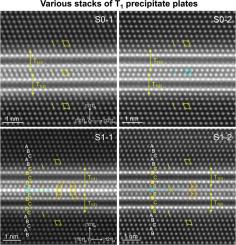Al-Cu-Li-Mg-Ag合金中的T1沉淀堆积
IF 14.3
1区 材料科学
Q1 MATERIALS SCIENCE, MULTIDISCIPLINARY
引用次数: 0
摘要
基于Al-Cu-Li-Mg-Ag体系的合金具有优异的力学性能,这是由于形成了大长径比(>;50:1)在α- al矩阵的{111}α平面上。在Al-Cu-Li-Mg-Ag合金等温时效后,观察到相同变体的单个T1沉淀板(每个厚度为~ 1nm)形成堆叠。这些堆积经常被含糊地描述为“更厚”或“粗糙”的T1沉淀。因此,很难回答有关微量合金元素Mg和Ag在T1析出物中的分布的关键问题。在这项工作中,使用原子分辨率高角度环形暗场扫描透射电子显微镜(STEM)和能量色散x射线光谱学(STEM)来检查这种堆叠。发现这些堆叠中的单个T1板要么直接排列在彼此的顶部,没有任何中间的原子面(S0),要么被额外的堆叠断层面(S1)分开。Ag偏析在S0和S1层(S1-1)的内部区域被观察到,特别是在两个堆叠的T1板接触的地方,而Mg似乎均匀分布在整个堆栈中,在特定原子层中没有任何明显的富集。在S1层(S1-2)中,Ag不存在,而Cu在层内的层断面上富集。通过密度泛函理论计算进一步阐述了实验观察到的元素分布模式。本文章由计算机程序翻译,如有差异,请以英文原文为准。

T1 precipitate stacks in an Al-Cu-Li-Mg-Ag alloy
Alloys based on the Al-Cu-Li-Mg-Ag system can develop superior mechanical properties due to the formation of T1 precipitate plates (Al2CuLi, space group: P6/mmm) with large aspect ratios (> 50:1) on {111}α planes of the α-Al matrix. Individual T1 precipitate plates of the same variant, each of ∼1 nm thickness, have been observed to form a stack after isothermal ageing of Al-Cu-Li-Mg-Ag alloys. These stacks are frequently—but ambiguously—described as “thicker” or “coarsened” T1 precipitates. As a result, it becomes difficult to answer key questions regarding the distribution of micro-alloying elements, Mg and Ag, within the T1 precipitate. In this work, atomic-resolution high-angle annular dark-field scanning transmission electron microscopy (STEM) and energy-dispersive X-ray spectroscopy STEM were used to examine such stacks. It is found that individual T1 plates within these stacks are arranged either directly on top of each other without any intervening atomic plane (S0) or are separated by an additional stacking fault plane (S1). Ag segregation is observed within the interior regions of S0 and one type of S1 stacks (S1-1), specifically where the two stacked T1 plates make contact, whereas Mg appears to be uniformly distributed across the whole stack, without any noticeable enrichment in a specific atomic layer. In the other type of S1 stacks (S1-2), Ag is absent, while Cu is enriched in the stacking fault plane within the stack. The elemental distribution patterns observed experimentally were further elaborated by density functional theory calculations.
求助全文
通过发布文献求助,成功后即可免费获取论文全文。
去求助
来源期刊

Journal of Materials Science & Technology
工程技术-材料科学:综合
CiteScore
20.00
自引率
11.00%
发文量
995
审稿时长
13 days
期刊介绍:
Journal of Materials Science & Technology strives to promote global collaboration in the field of materials science and technology. It primarily publishes original research papers, invited review articles, letters, research notes, and summaries of scientific achievements. The journal covers a wide range of materials science and technology topics, including metallic materials, inorganic nonmetallic materials, and composite materials.
 求助内容:
求助内容: 应助结果提醒方式:
应助结果提醒方式:


